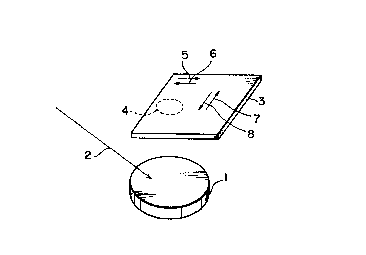Some of the information on this Web page has been provided by external sources. The Government of Canada is not responsible for the accuracy, reliability or currency of the information supplied by external sources. Users wishing to rely upon this information should consult directly with the source of the information. Content provided by external sources is not subject to official languages, privacy and accessibility requirements.
Any discrepancies in the text and image of the Claims and Abstract are due to differing posting times. Text of the Claims and Abstract are posted:
| (12) Patent: | (11) CA 2016028 |
|---|---|
| (54) English Title: | METHOD OF FABRICATING OXIDE SUPERCONDUCTING FILM |
| (54) French Title: | PROCEDE DE FORMATION DE PELLICULES D'OXYDE SUPRACONDUCTRICE |
| Status: | Expired and beyond the Period of Reversal |
| (51) International Patent Classification (IPC): |
|
|---|---|
| (72) Inventors : |
|
| (73) Owners : |
|
| (71) Applicants : |
|
| (74) Agent: | SMART & BIGGAR LP |
| (74) Associate agent: | |
| (45) Issued: | 1999-07-20 |
| (22) Filed Date: | 1990-05-03 |
| (41) Open to Public Inspection: | 1990-11-19 |
| Examination requested: | 1990-05-03 |
| Availability of licence: | N/A |
| Dedicated to the Public: | N/A |
| (25) Language of filing: | English |
| Patent Cooperation Treaty (PCT): | No |
|---|
| (30) Application Priority Data: | ||||||
|---|---|---|---|---|---|---|
|
A laser beam (2) is applied to a target (1) of an
oxide superconductive material, to deposit atoms and/or
molecules which are scattered from the target (1) on a
first portion (4) of a substrate (3) under an atmosphere
containing oxygen for a start. Then, the substrate (3) is
moved to deposit atoms and/or molecules scattered from the
target (10) on a second portion, which is different form
the first portion (4) of the substrate (3), under the
atmosphere containing oxygen. At this time, the first
portion (4) is subjected to oxygen annealing. These
deposition steps are repeated until an oxide
superconducting film of a desired thickness is obtained.
Un faisceau laser (2) est appliqué sur une cible (1) en oxyde supraconducteur pour déposer des atomes et/ou molécules arrachés de ladite cible (1) sur une première partie (4) d'un substrat (3) sous atmosphère renfermant de l'oxygène au début. Puis, le substrat (3) est déplacé en vue du dépôt d'atomes et/ou molécules arrachés de la cible (10) sur une seconde partie du substrat (3), différente de la première partie (4), sous atmosphère renfermant de l'oxygène. cet instant, la première partie (4) subit un recuit à l'oxygène. Ces étapes sont répétées jusqu'à obtention d'une couche d'oxyde supraconducteur d'épaisseur appropriée.
Note: Claims are shown in the official language in which they were submitted.
Note: Descriptions are shown in the official language in which they were submitted.

2024-08-01:As part of the Next Generation Patents (NGP) transition, the Canadian Patents Database (CPD) now contains a more detailed Event History, which replicates the Event Log of our new back-office solution.
Please note that "Inactive:" events refers to events no longer in use in our new back-office solution.
For a clearer understanding of the status of the application/patent presented on this page, the site Disclaimer , as well as the definitions for Patent , Event History , Maintenance Fee and Payment History should be consulted.
| Description | Date |
|---|---|
| Inactive: IPC expired | 2023-01-01 |
| Inactive: IPC from MCD | 2006-03-11 |
| Time Limit for Reversal Expired | 2001-05-03 |
| Letter Sent | 2000-05-03 |
| Grant by Issuance | 1999-07-20 |
| Inactive: Cover page published | 1999-07-19 |
| Inactive: Received pages at allowance | 1999-01-29 |
| Pre-grant | 1999-01-29 |
| Inactive: Final fee received | 1999-01-29 |
| Letter Sent | 1998-11-12 |
| Notice of Allowance is Issued | 1998-11-12 |
| Notice of Allowance is Issued | 1998-11-12 |
| Inactive: Status info is complete as of Log entry date | 1998-11-06 |
| Inactive: Application prosecuted on TS as of Log entry date | 1998-11-06 |
| Inactive: Approved for allowance (AFA) | 1998-10-29 |
| Inactive: Adhoc Request Documented | 1997-05-05 |
| Deemed Abandoned - Failure to Respond to Maintenance Fee Notice | 1997-05-05 |
| Application Published (Open to Public Inspection) | 1990-11-19 |
| Request for Examination Requirements Determined Compliant | 1990-05-03 |
| All Requirements for Examination Determined Compliant | 1990-05-03 |
| Abandonment Date | Reason | Reinstatement Date |
|---|---|---|
| 1997-05-05 |
The last payment was received on 1999-05-03
Note : If the full payment has not been received on or before the date indicated, a further fee may be required which may be one of the following
Patent fees are adjusted on the 1st of January every year. The amounts above are the current amounts if received by December 31 of the current year.
Please refer to the CIPO
Patent Fees
web page to see all current fee amounts.
| Fee Type | Anniversary Year | Due Date | Paid Date |
|---|---|---|---|
| MF (application, 8th anniv.) - standard | 08 | 1998-05-04 | 1998-02-25 |
| Final fee - standard | 1999-01-29 | ||
| MF (application, 9th anniv.) - standard | 09 | 1999-05-03 | 1999-05-03 |
Note: Records showing the ownership history in alphabetical order.
| Current Owners on Record |
|---|
| SUMITOMO ELECTRIC INDUSTRIES, LTD. |
| Past Owners on Record |
|---|
| SHIGERU OKUDA |